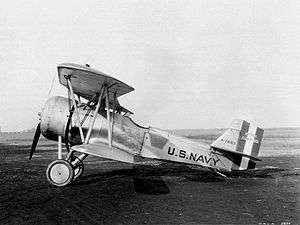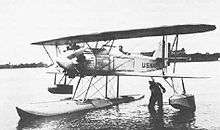Curtiss F7C Seahawk
| F7C-1 Seahawk | |
|---|---|
 | |
| The Curtiss XF7C-1 in June 1929 | |
| Role | Fighter |
| Manufacturer | Curtiss Aeroplane and Motor Company |
| First flight | 28 February 1927 |
| Retired | 1933 |
| Primary user | United States Marine Corps |
| Number built | 17 |
|
| |
The Curtiss F7C Seahawk was a carrier-capable biplane fighter aircraft of the United States Navy Marine Corps in the late 1920s and early 1930s.
Design and development
Curtiss' Model 43 was their first aircraft designed expressly for the Navy, rather than a modified Army type. While clearly a descendant of the P-1 Hawk, its wings were constant-chord rather than tapered, and the upper wing had a slight sweepback. The engine was a 450 hp (340 kW) Pratt & Whitney R-1340-B Wasp radial. Entirely fabric-covered, the top wing was framed with spruce, while the fuselage was built from a combination of aluminum and steel tubing, sufficiently strong to serve as a dive bomber as well as a fighter.
Operational history
The prototype XF7C-1 first flew on 28 February 1927. After some modification demanded by the Navy (such as the wing sweepback), 17 production aircraft F7C-1 Seahawks were built, and entered service in the USMC's VF-5M at Quantico. In 1930 VF-9M organized the Marines' first aerobatic stunt team, "The Red Devils", with F7Cs featuring red painted noses.[1][2] They continued in service until 1933.
Variants

- XF7C-1: Prototype aircraft; one built.
- F7C-1 Seahawk: Singe-seat fighter aircraft, main production version; 17 built.
- XF7C-2: Single F7C-1 conversion for evaluation with the 575 hp (429 kW) Wright R-1820-1 radial engine and large-span full-span flaps.
- XF7C-3: A demonstration prototype for China with an armament of four .30 in (7.62 mm) M1919 Browning machine guns, I-type interplane struts, and ailerons on both the upper and lower wings rather than on just the upper wing. The type was superseded by the Model 64, F11C Goshawk.
Operators
Specifications (F7C-1)
General characteristics
- Crew: 1
- Length: 22.6 ft (6.88 m)
- Wingspan: 32.67 ft (9.34 m)
- Height: 9.71 ft (2.96 m)
- Wing area: 275 ft² (25.55 m²)
- Empty weight: 2,053 lb (931 kg)
- Max. takeoff weight: 2,782 lb (1,262 kg)
- Powerplant: 1 × Pratt & Whitney R-1340-B Wasp radial engine, 450 hp (336 kW)
Performance
- Maximum speed: 155 mph (249 km/h)
- Cruise speed: 150 mph (241 km/h)
- Service ceiling: 22,100 ft (6735 m)
- Rate of climb: 1,860 ft/min (9.45 m/s)
Armament
- Guns: 2 × fixed .30 in (7.62 mm) Browning machine guns in the forward fuselage
See also
| Wikimedia Commons has media related to Curtiss F7C Seahawk. |
References
Notes
Bibliography
- Barrow, Jess C. WWII Marine Fighting Squadron Nine (VF-9M) (Modern Aviation Series). Blue Ridge Summit, Pennsylvania: Tab Books Inc., 1981. ISBN 978-0-8306-2289-4.
- Eden, Paul and Soph Moeng, eds. cover The Complete Encyclopedia of World Aircraft. London: Amber Books Ltd., 2002. ISBN 0-7607-3432-1.
- Jones, Lloyd S. U.S. Naval Fighters. Fallbrook, California: Aero Publishers, 1977, pp. 50–52. ISBN 0-8168-9254-7.